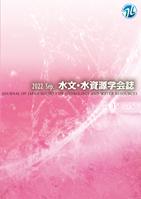
- Issue 6 Pages 373-
- Issue 5 Pages 323-
- Issue 4 Pages 253-
- Issue 3 Pages 173-
- Issue 2 Pages 101-
- Issue 1 Pages 1-
- |<
- <
- 1
- >
- >|
-
[in Japanese]2022 Volume 35 Issue 5 Pages 323-324
Published: September 05, 2022
Released on J-STAGE: September 28, 2022
JOURNAL FREE ACCESSDownload PDF (254K)
-
Osamu ITAGAKI, Miho OHARA, Toshio KOIKE2022 Volume 35 Issue 5 Pages 325-338
Published: September 05, 2022
Released on J-STAGE: September 28, 2022
JOURNAL FREE ACCESSIn light of the frequent occurrence of unprecedented heavy rains and floods attributable to climate change effects, the importance of the “River Basin Disaster Resilience and Sustainability by All” initiative is being emphasized and promoted strongly. This paper proposes a flood damage reduction measure by spillway installation on a riverine levee in a protected area. It can prevent levee breaches to reduce flood waters and flood damage. Moreover, this paper presents results of trial application of the method to an area where severe flood disasters have occurred in recent years. Results show that the measure considerably reduces the flooded area, the days required for drainage, and house flood depths. Results also indicate that the average annual damage to paddy fields in the area can be expected to decrease, although the inundation frequency will increase.
View full abstractDownload PDF (1852K)
-
Total Storage Comparison Using a Tank Model and Soil Water Index Based on Geology and Watershed SizeShoji NOGUCHI, Yoshiko KOSUGI, Satoru TAKANASHI2022 Volume 35 Issue 5 Pages 339-347
Published: September 05, 2022
Released on J-STAGE: September 28, 2022
JOURNAL FREE ACCESSThe Soil Water Index is used to assess risks of sediment-related disasters. This study compared the total storage of a three-stage tank mode with different geologies and examined the rainfall history of total storage. Furthermore, effects of the granite watershed size on the total storage were examined. Total storage was calculated using hourly precipitation data accumulated for 50 years at the Kyoto Local Meteorological Observatory as an input value. From multiple comparisons, the average value of the total storage during rainfall events based on the geology of the large watershed revealed considerable differences between granite and Paleozoic rock, granite and Tertiary rock, volcanic rock and Paleozoic rock, and volcanic rock and Tertiary rock. Total storage tends to increase with the total rainfall or maximum rainfall intensity during a rainfall event, and the rate of increase of the total storage varied in the order of Tertiary < Paleozoic < granite < volcanic rock. The historical ranking of the total storage was similar by geology, as stated in earlier reports. The total storage in the small watershed with granite geology differed considerably from the total storage in the large watershed with granite geology. The total storage in the small watershed tended to increase concomitantly with increasing total rainfall or rainfall intensity, but the historical ranking of the total storage differed depending on the watershed size. More examples of parameter values for the three-stage tank model in series in small watersheds must be accumulated to quantify the total storage of the tank model based on watershed characteristics.
View full abstractDownload PDF (1045K)
-
[in Japanese]2022 Volume 35 Issue 5 Pages 348
Published: September 05, 2022
Released on J-STAGE: September 28, 2022
JOURNAL FREE ACCESSDownload PDF (110K)
-
[in Japanese], [in Japanese], [in Japanese], [in Japanese]2022 Volume 35 Issue 5 Pages 349-357
Published: September 05, 2022
Released on J-STAGE: September 28, 2022
JOURNAL FREE ACCESSDownload PDF (603K)
-
Kaoru KAKINUMA2022 Volume 35 Issue 5 Pages 358
Published: September 05, 2022
Released on J-STAGE: September 28, 2022
JOURNAL FREE ACCESS
-
Yoshito SUGAWARA2022 Volume 35 Issue 5 Pages 359
Published: September 05, 2022
Released on J-STAGE: September 28, 2022
JOURNAL FREE ACCESSI describe my research on the development of unsaturated infiltration models to be applied to distributed runoff models. I also introduce my favorite animal, the capybara, and mention the relationship between hydrology and capybaras.
View full abstractDownload PDF (199K)
- |<
- <
- 1
- >
- >|